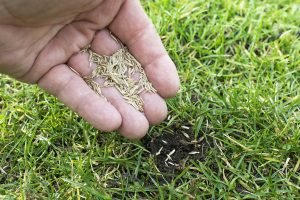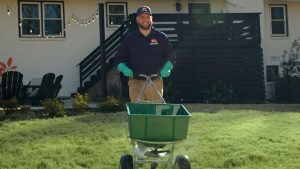[vc_row][vc_column][vc_column_text]While it might be easy to roll your trash up to the curb once a week and forget about it, that isn’t the most environmentally sustainable solution. A significant portion of the waste that ends up in landfills is food. If you can recycle paper, plastic, metal and other materials, why not food, too? Here’s your solution.
Composting is nature’s process of recycling decomposed organic materials into a rich soil called compost. Backyard composting is the controlled acceleration of that same natural process. While you might think of composting as something for cooks or gardeners, it definitely isn’t limited to them. Composting is for anyone who discards leftovers. Yes, that includes the pizza you didn’t finish over the weekend.
Benefits
By composting, you create rich, organic nutrients for your lawn and garden which can also help retain moisture in the soil. Composting also allows microscopic organisms to grow in the soil, breaking down organic material for plant use and warding off plant disease. Considering you are compositing from the recycled kitchen and yard waste, you’re avoiding the chemical fertilizers that can be detrimental to your health.
Aside from your direct benefits, composting also reduces the landfill waste in the country. Currently, North American landfills are quickly reaching maximum capacity or even shutting down due to overfilling. What many people don’t know is that one-third of landfill waste is compostable materials. If everyone created their own compost pile and recycled metals, plastics and papers, we could reduce our landfill usage by at least half. That’s a pretty amazing number if you ask us, and a great excuse for creating your own compost pile.
What You’ll Need
Making your own compost pile is pretty simple. You just need to layer organic materials, from grass clippings and dried leaves to kitchen scraps and shredded papers, with soil to create the perfect compost.
Depending on what you want to accomplish will determine the scale of your bin or pile. If you want to fertilize your garden or yard, a larger outdoor bin might be a great option for you. If you want to leave less of a carbon footprint, a smaller indoor bin could be just what you need. You can keep it under your sink and out of sight. All you really need to do to care for your pile is turn it regularly and add new materials (which shouldn’t be too hard since we eat every day).
What to Compost
Anything that was once living can be put into the compost. Just be sure to add in materials that are nitrogen-rich as well as carbon-rich materials. Here’s a list of typical ingredients:
- Leaves – Carbon
- Kitchen waste – Nitrogen
- Grass clippings – Nitrogen
- Coffee grounds – Nitrogen
- Pine needles – Carbon
- Newspaper – Carbon
- Cardboard – Carbon
- Sawdust – Carbon
- Eggshells (Crushed) – Neutral
- Tea leaves – Nitrogen
- Dryer lint – Carbon
- Flowers – Nitrogen
- Gutter debris – Nitrogen
The only things to avoid composting include fats, pet droppings or animal products. These can attract pests, which can spread disease.
Happy composting! Be sure to ask your gutter technician to save that gutter debris for your compost pile.
Ready to schedule your first gutter cleaning?
Get $25 Off First Time Gutter Cleaning!
[/vc_column_text][/vc_column][/vc_row]



